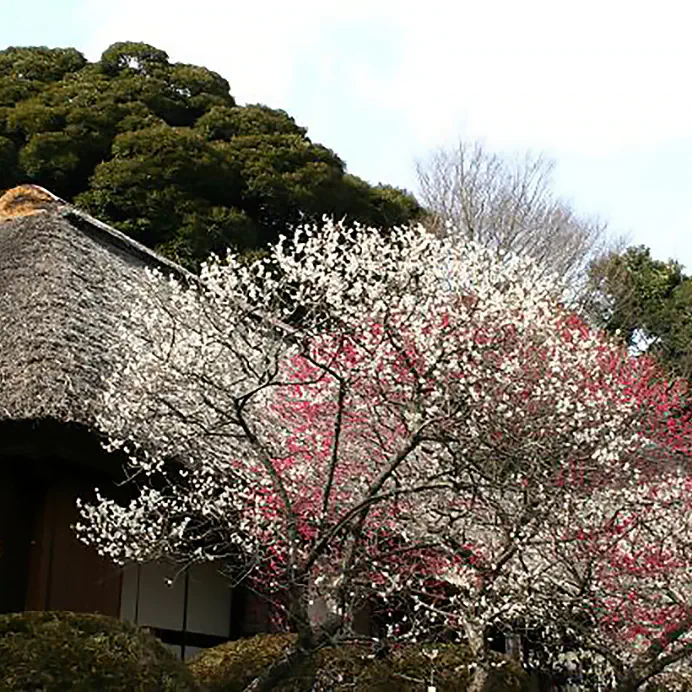
Renowned Since the Edo Period

Shōren-an and Plum Trees
In the Kyoho era (1716 – 1735) of the Edo period, Shōrenji temple was rebuilt on this site by the nun Jushouin Jigaku Genchouni. Keiō Mogusaen grew over the subsequent years. The park’s renowned jushōbai (plum trees) are said to have been planted by the nun herself. In peak plum blossom season, some 500 trees of 50 plum species bloom in competition as the garden reaches its crowning glory.

Mt. Tsukuba in the Distance, Warbler Chirps in Spring

Shinji-ike Pond
Keiō Mogusaen sits in a corner of the Tama hills, a lush area that is home to abundant natural life.
In addition to great views of the park’s features, Lookout Point also offers views on clear days of downtown Shinjuku, Tokyo Skytree, and, from the square in front of Shōren-an, even Mt. Tsukuba.
Home to any number of wild birds, visitors are treated to the call of the warbler in spring and the little cuckoo in early summer.
Celebrated and Cherished by All
Introduced as a renowned spot near Edo in such historical books as the Guide to Famous Edo Sites, Shinji-ike Pond has been visited by many famous writers and poets.
Notably, Bokusui Wakayama penned Hitori Utaeru, a tanka about his lost love, Saeko, at this site.
In the trees around the pond can be found a tanka monument to Wakayama designed by his eldest son, Tabito, and a haiku monument to Matsuo Bashō.

Shōren-an
Shōren-an Hermitage is named after Shōren-ji Temple which existed there in the Edo period.
The temple was rebuilt by Jusho-in Jigaku Genchōni, the wife of the lord of Odawara Castle, as a memorial to Tokugawa Ieyasu’s eldest son Nobuyasu.
The magnificent plum tree in the front is said to have been planted by Jusho-in herself.
With its warm and homey thatched roof, Shōren-an Hermitage conveys a sense of comfort and softness.
The garden is also available for private parties depending on the season.
Sanreki-an
Sanreki-an Teahouse is made from solid Akita cedar, used in abundance.
Take just one step through the Baiken-mon Gate and you'll find yourself in another world.
Visitors enjoy our flowers and other natural scenery that changes throughout the year, especially the beautiful maple leaves you can see from November to December. With autumn foliage, bamboo, and a teahouse, this is an ideal location, with everything you could want.




9 a.m.to 5 p.m.
*Park closes at 4:30 p.m. in November and December.
* No pets are allowed in the park.
Wednesdays (Also days following holidays, and New Year’s period December 30 –January 3)
* Open on these days during special events
Adults: 500 yen, Children: 100 yen
*2 discount for disabled persons with a disability certificate
Annual Passport / on-sale price: 2,000 yen
(Valid for 1 year from the date of issue)
*Adult tickets only. No children's tickets are available.
*We welcome all kinds of student club and circle activities.